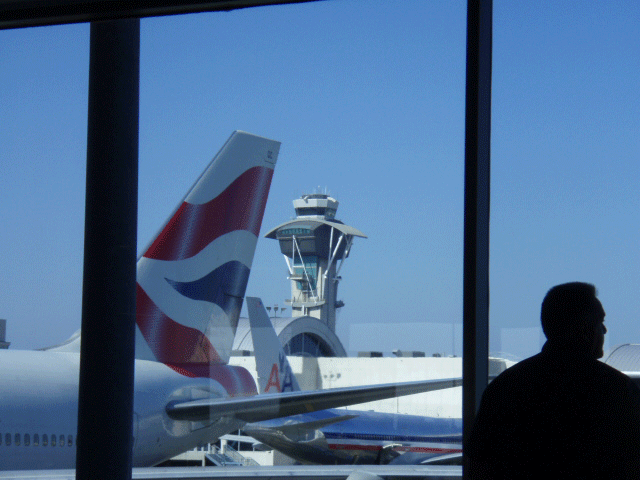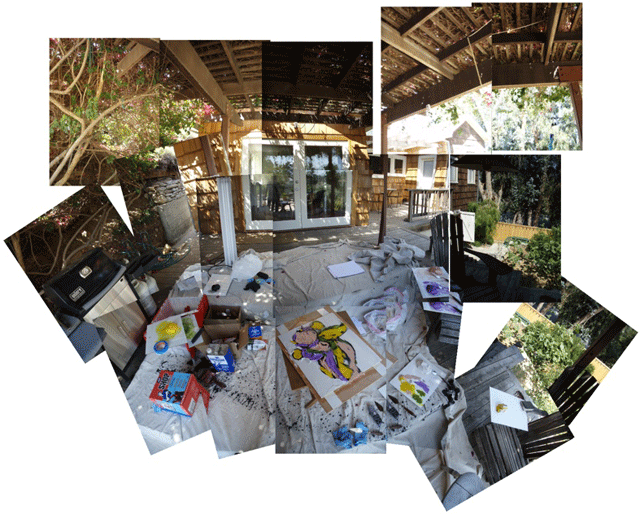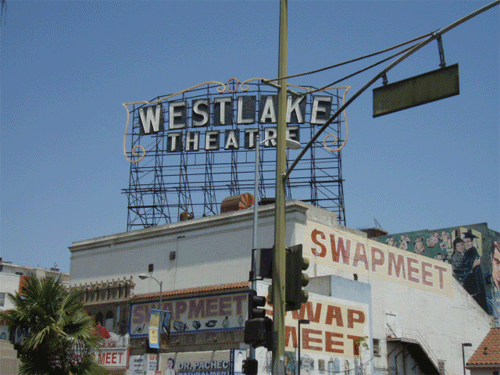June 29, 2007
Admin: Standby
I?m still settling into the routine here, and I hope to have the time to hack this ISP system soon to continue regular blogging. Guests and family and numerous have-to-dos are running interferance.
Henry, Alberto and I worked together last night, painting separately by and large as Kiko modelled for us. This, our tribute to a true son of Tossa. Henry took control of the kitchen and we grilled some meat in the manly way to smooth a session that lasted until five am. Pictures of that are in the laptop and I hope to be able to get them online soon.
Meanwhile, my family from Australia are coming in, a birthday being the ostensible reason for the get together. Our family has been fragmented over the years, the dream of a reunion is extra special as it is likely to remain a dream, alas alack.
June 26, 2007
Tossa Summer 2007
I?m back in Tossa to paint for another summer, the past four days are a sunburned sangria/cava blur. Henry Taylor and Gerard Smulevich are "in the house", lots of pictures and movies too (the camera Hiroshi influenced me to buy in Tokyo can shoot fotos underwater.... and they look great). Henry has charmed this town off its? feet, man oh man. Gerry has great stories about his class in Barcelona. My cousin Patrica is having a blow out birthday party here, and many relatives are vectoring into town for it, so expect something of this to come too.
There is much to do to get set up here, the computer ISP interface is a bit of a problem. I?ve got some problems with materials and I have yet to get to Barcelona to talk to the gallery there. I hope to be back in the saddle soon, blog-wise, maybe in a week or sooner.
More to come....
June 21, 2007
Car City
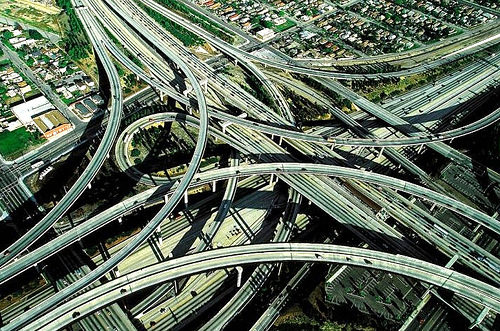
Cool Link via Boing Boing
See this for some context.
June 20, 2007
Habada Habada
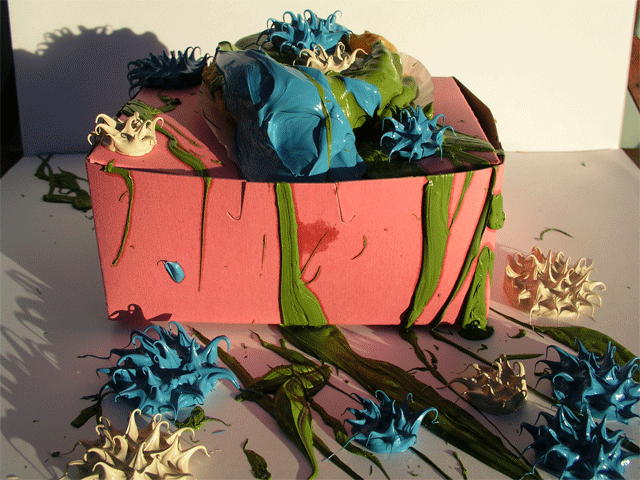
It's been a surreal two weeks since I got back from Tokyo. No time to start anything new, any painting done was simply and finally a mechanical thing. Tons of small things, house projects and repairs deferred; a to-do list struck off and now I have less than a day before departure for Spain and I'm not even packed yet.
There are tons of things to post, much of it spilled from my grasp over time. I'll try to post it as the summer goes by as I have here in this post, a picture of a stretch-for-a-folly-offered-to-a-charity-auction-that-never-followed-through.
There's much to do because in about 40 or so hours, I'll be in Tossa.
June 17, 2007
Voyager

As some of you may know, I am a fan of time and scale lines. I thought of Hiroshi when I read this article about the realities of space travel since he is a huge fan of the Powers of Ten by the famous husband and wife designer team, Charles and Ray Eames. Hiroshi spoke of his regard of his paintings in these terms, a floating aloft and away into space as small conflates with the large, a vital key in understanding his paintings.
Today, I came across a spoilsport who argues for some perspective when we think about space exploration:
...And I don't want to spend much time talking about the unspoken ideological underpinnings of the urge to space colonization, other than to point out that they're there, that the case for space colonization isn't usually presented as an economic enterprise so much as a quasi-religious one. "We can't afford to keep all our eggs in one basket" isn't so much a justification as an appeal to sentimentality, for in the hypothetical case of a planet-trashing catastrophe, we (who currently inhabit the surface of the Earth) are dead anyway. The future extinction of the human species cannot affect you if you are already dead: strictly speaking, it should be of no personal concern.Historically, crossing oceans and setting up farmsteads on new lands conveniently stripped of indigenous inhabitants by disease has been a cost-effective proposition. But the scale factor involved in space travel is strongly counter-intuitive.
Here's a handy metaphor: let's approximate one astronomical unit ? the distance between the Earth and the sun, roughly 150 million kilometres, or 600 times the distance from the Earth to the Moon ? to one centimetre. Got that? 1AU = 1cm. (You may want to get hold of a ruler to follow through with this one.)

Towards the end of this missive, this writer notes an exception to his rule of the limits of scale, the space elevator!:
Let me repeat myself: we are not going there with rockets. At least, not the conventional kind ? and while there may be a role for nuclear propulsion in deep space, in general there's a trade-off between instantaneous thrust and efficiency; the more efficient your motor, the lower the actual thrust it provides. Some technologies such as the variable specific impulse magnetoplasma rocket show a good degree of flexibility, but in general they're not suitable for getting us from Earth's surface into orbit ? they're only useful for trucking things around from low earth orbit on out.Of course, I think vigorous human activity within one astronomical unit is just fine for our near future. Vigorous is a key word, it's time for us to ramp it up.Again, as with interstellar colonization, there are other options. Space elevators, if we build them, will invalidate a lot of what I just said. Some analyses of the energy costs of space elevators suggest that a marginal cost of $350/kilogram to geosynchronous orbit should be achievable without waving any magic wands (other than the enormous practical materials and structural engineering problems of building the thing in the first place). So we probably can look forward to zero-gee vacations in orbit, at a price. And space elevators are attractive because they're a scalable technology; you can use one to haul into space the material to build more. So, long term, space elevators may give us not-unreasonably priced access to space, including jaunts to the lunar surface for a price equivalent to less than $100,000 in today's money. At which point, settlement would begin to look economically feasible, except ...
Well Done Indeed
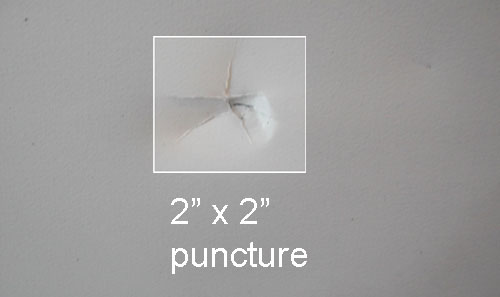
Chris Jagers shared a supercool paper repair technique in his excellent blog today. It's a keeper, bookmarks-wise.
June 15, 2007
WW IV
The battlefield is everywhere. Everyone is a combatant.
June 14, 2007
Ahora (casi)
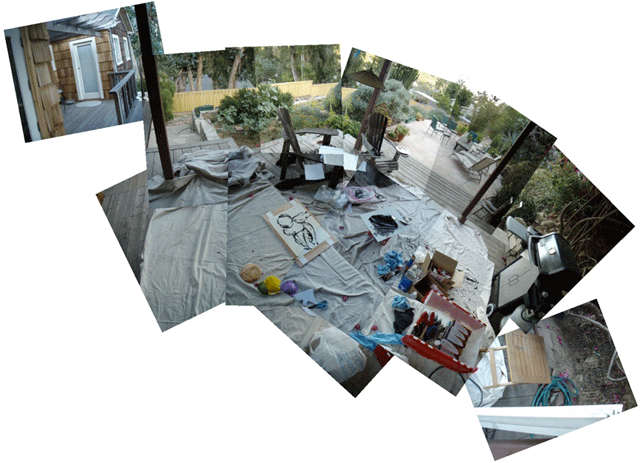
....three hours old.
Inspired by Hiroshi, I'm trying to paint at the house, the first time in many many years.
No Jerks

Matt Chambers will mount the summer show at Rental NY.
He assembled it with curator Catherine Taft, the title: "No Jerks".
I'm eager to read the curatorial statement.
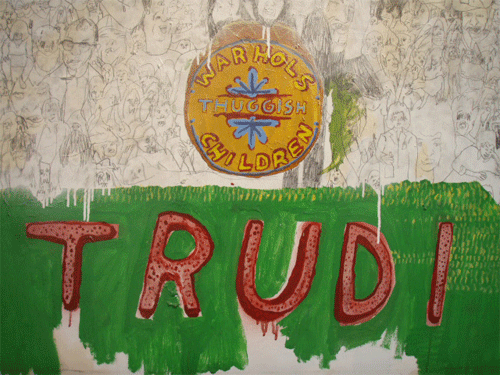
Matt Chambers also has a solo show up in David Quadrini's Angstrom Gallery at Culver City. A protean young artist, Matt emblazoned his installation with this graphic manifesto. A new factory with teeth? When is a thug not a jerk? I'm eager to read Matt's artist's statement too... but then he's not the statement writing type.
Installation fotos after the jump;
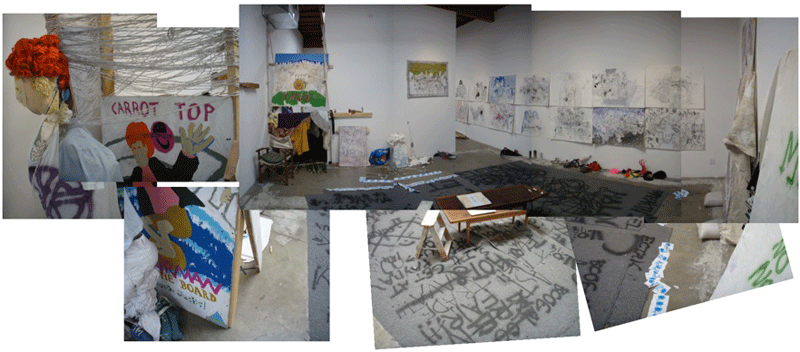
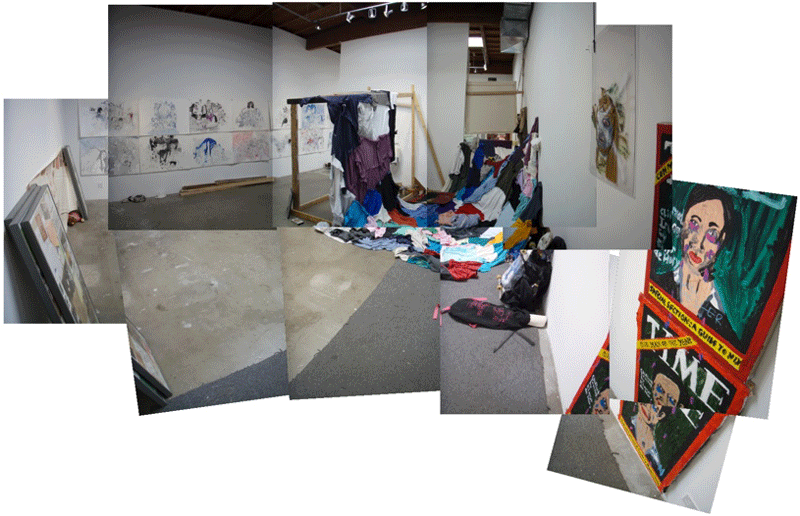
June 11, 2007
Nursed Notions and Hodgkin

Good bits from Howard Hodgkin in a BBC interview here:
HH: I think one of my great good fortunes as a painter is that I am not categorized and I am not a member of a school. Which perhaps gives me some slight advantage. When people look at a picture of mine, they don't first say: oh, one of those, which they would obviously with a great number of other artists working there.Hodgkin at the Tate here.
I've nursed a notion of creating representations of insubstantial "things" such as a conversation, for example. A transcription is one way, but I was thinking of how the notes taken during a meeting or classroom blackboards have the tracings of the conceptual peaks of a verbal transaction. Making a thing of this kind of event, a sculpture for example, has been a recurring concern. Hodgkin's representations of events is a good source to study in this regard.
June 9, 2007
Art Dept: Nagoya University
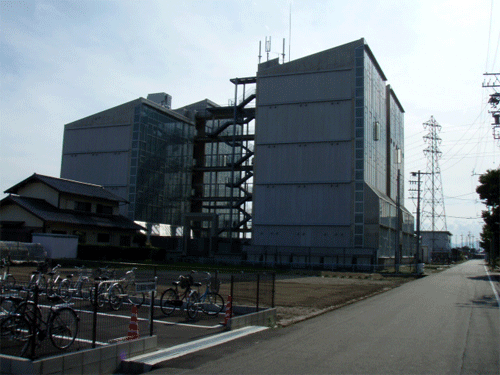
Hiroshi took me to his school where he teaches a painting studio. Earlier, he described the insider/outsider art universes in Japan, and the faculty/student population reflects this reality as well. Undergraduate studios, this is the first time the students are working on independent projects, each one flourescing into one of the two artworlds. Hiroshi becomes here a fisher of men (women, since the majority of the students there are female), waiting for the moment when each student opens up to what art can be, as we understand it in the international arena.
What follows is a 148 images, a walk through of several floors of art studios in the outskirts of Nagoya:

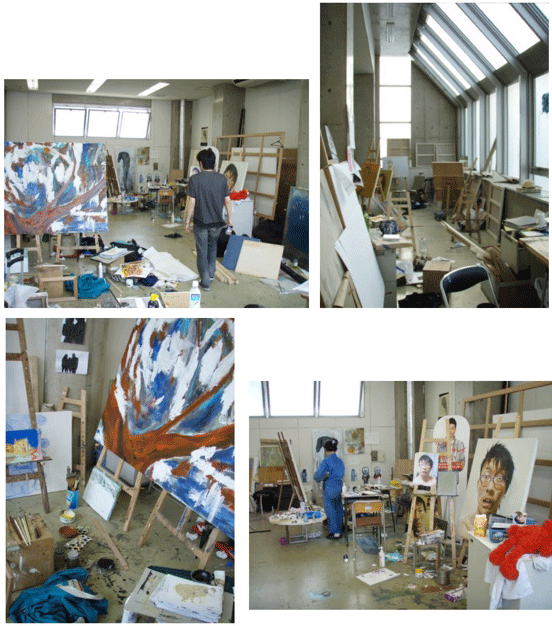

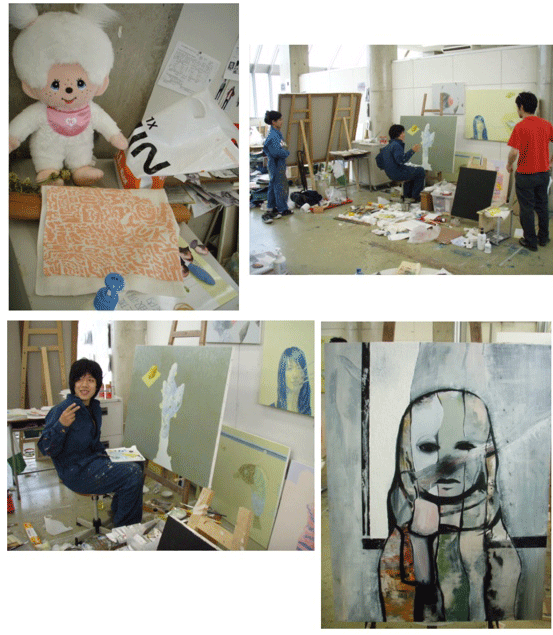
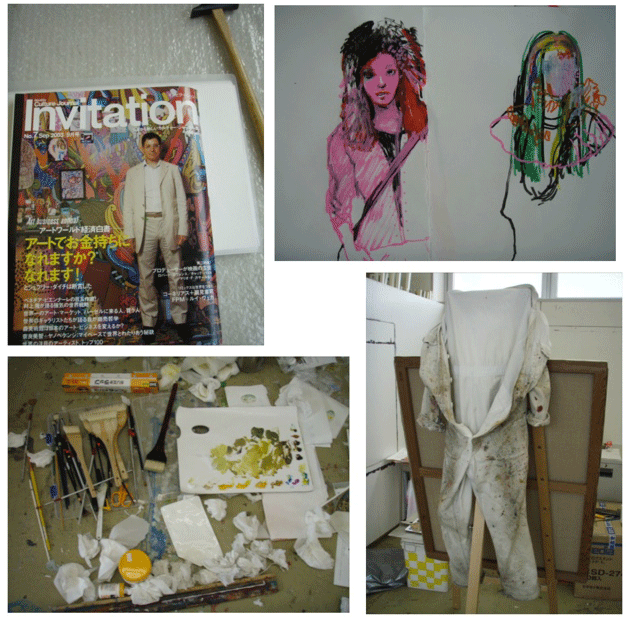
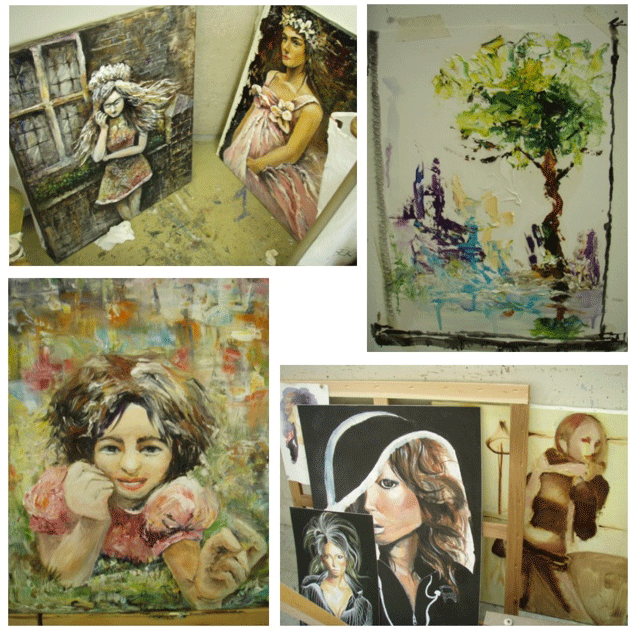
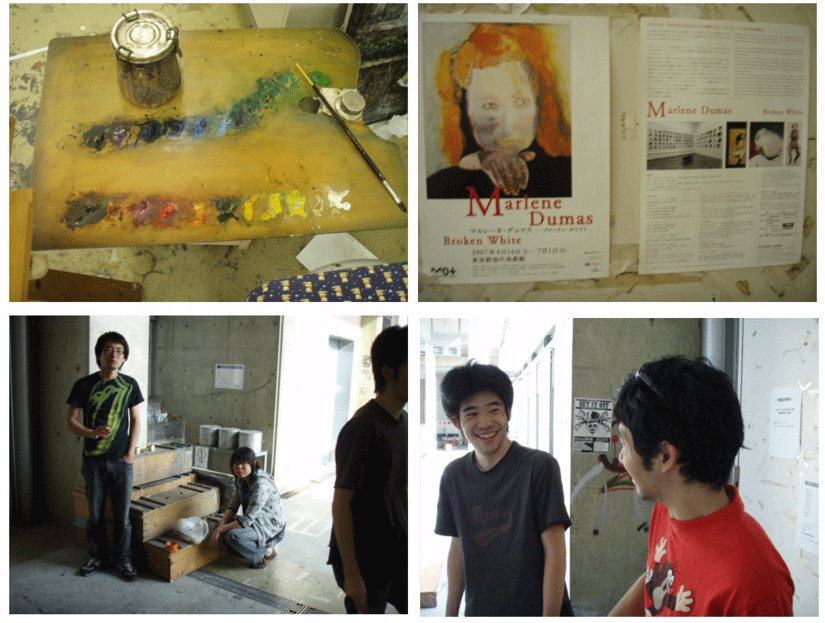
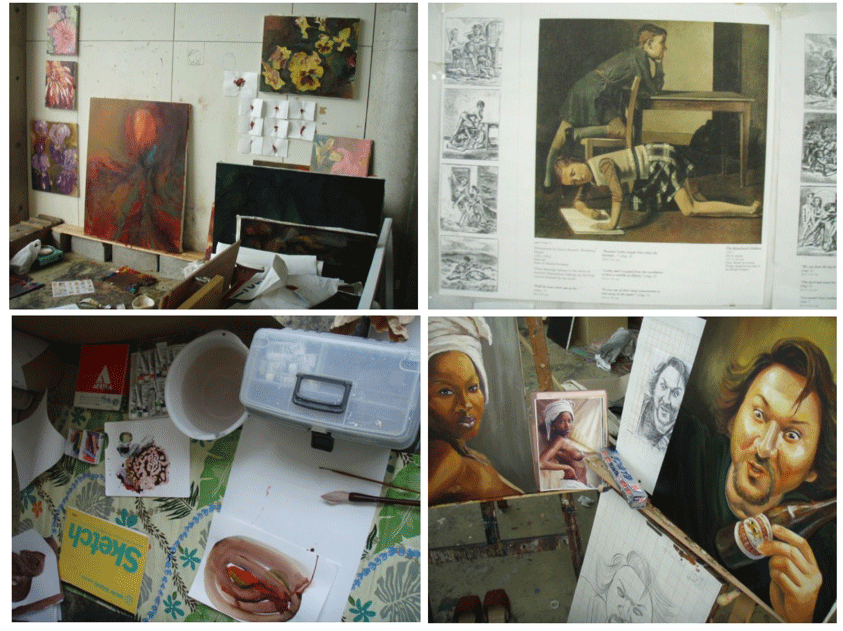

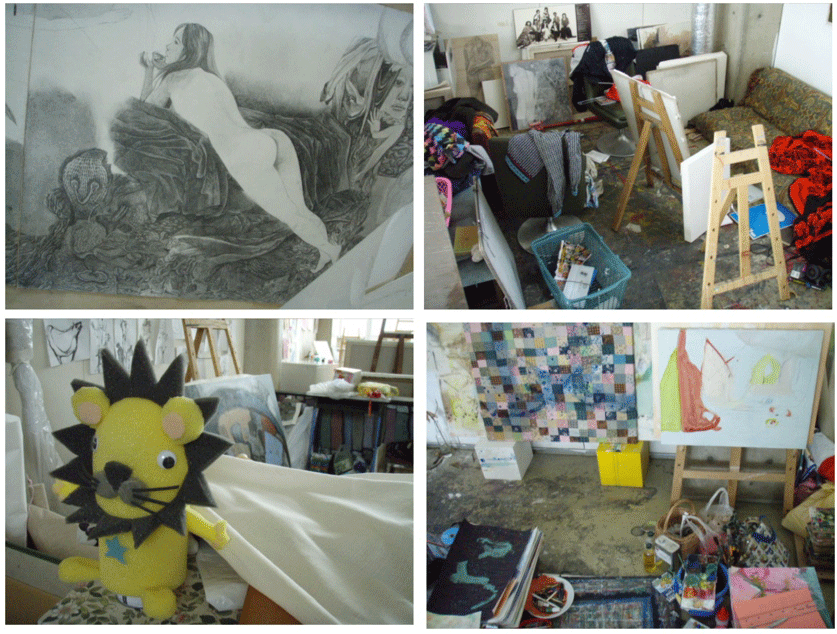
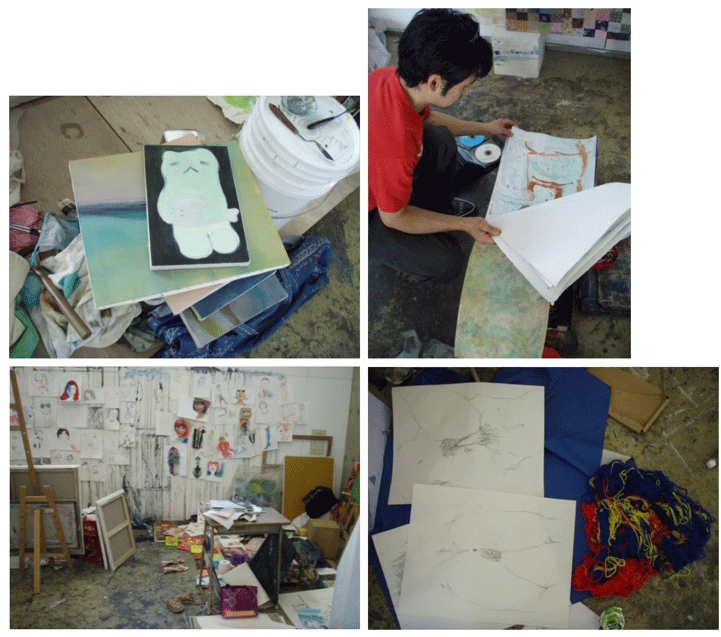
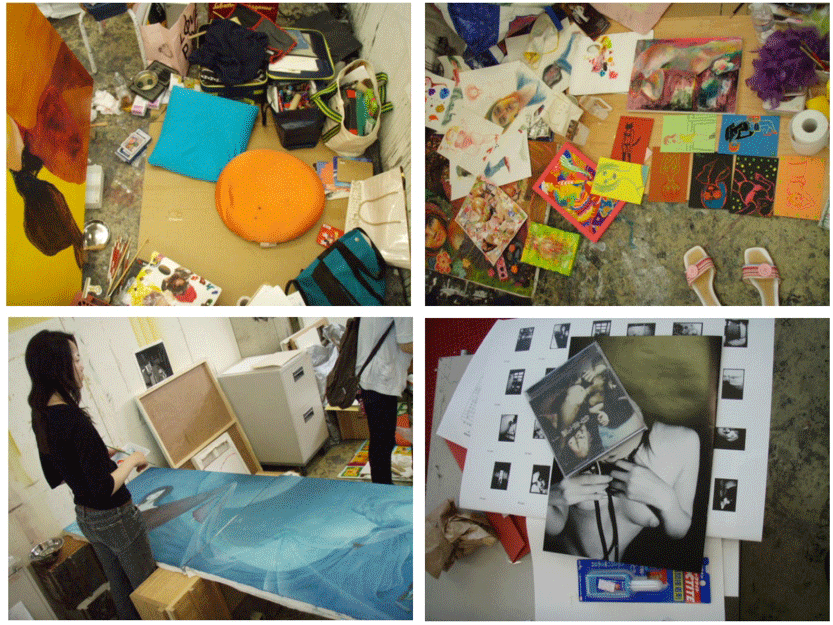
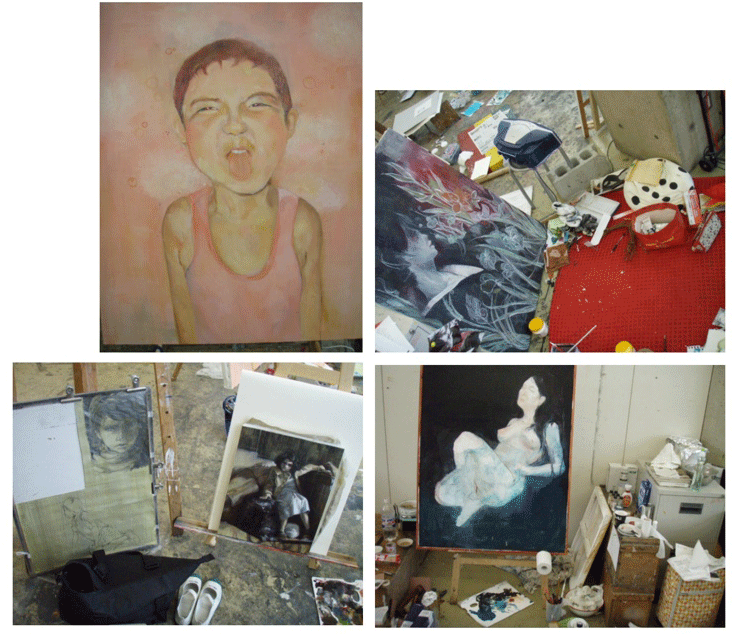

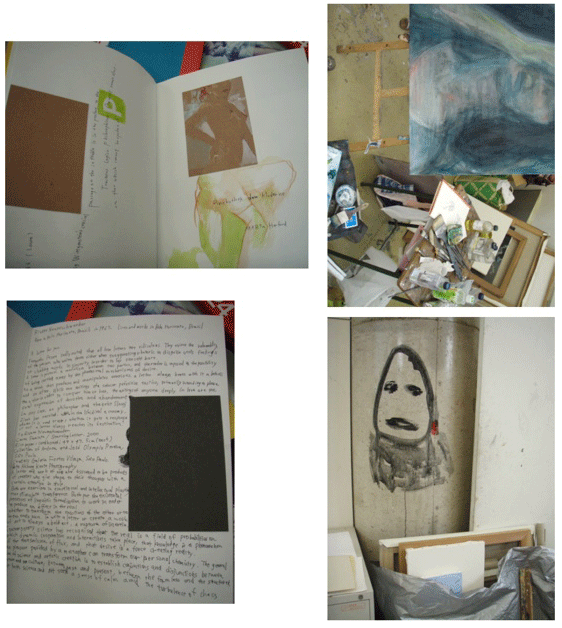

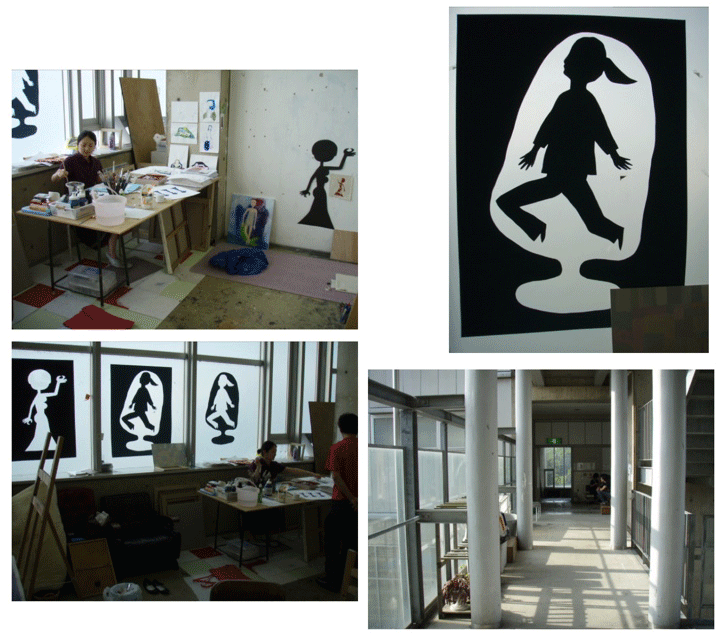
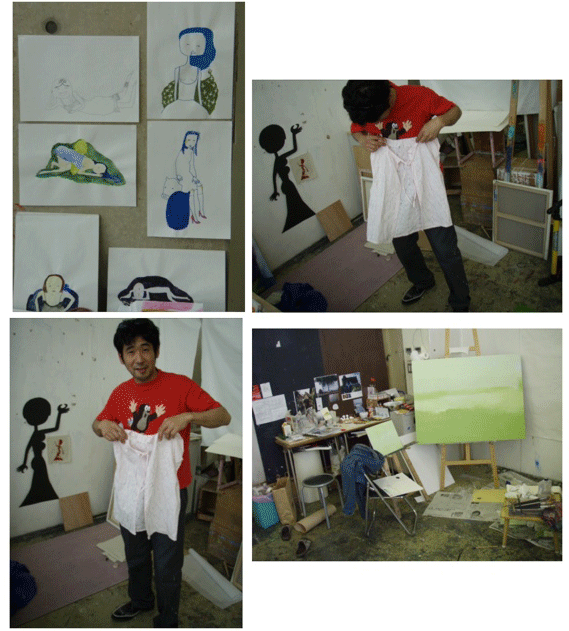
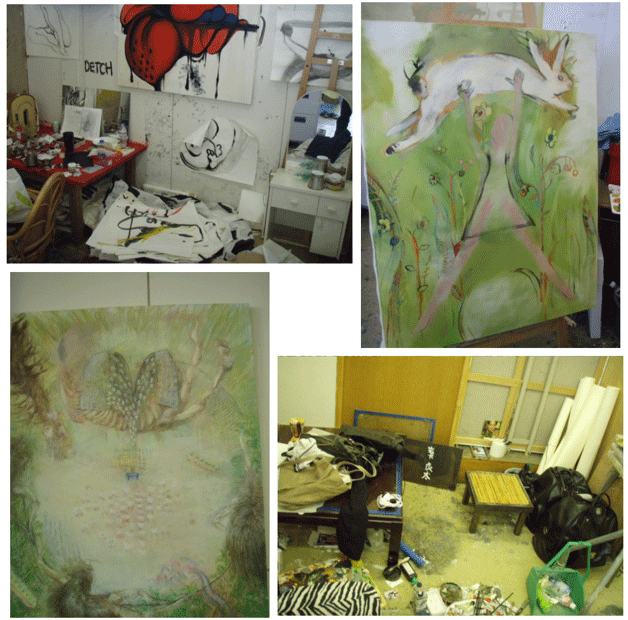
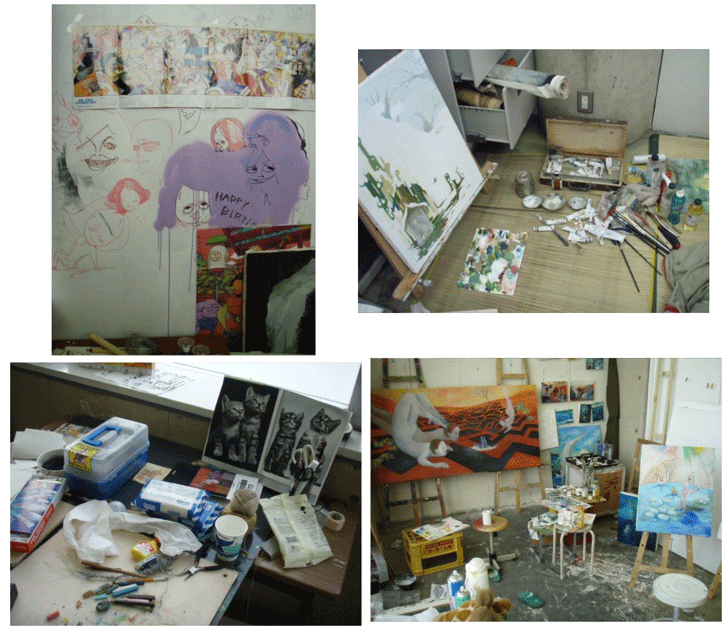

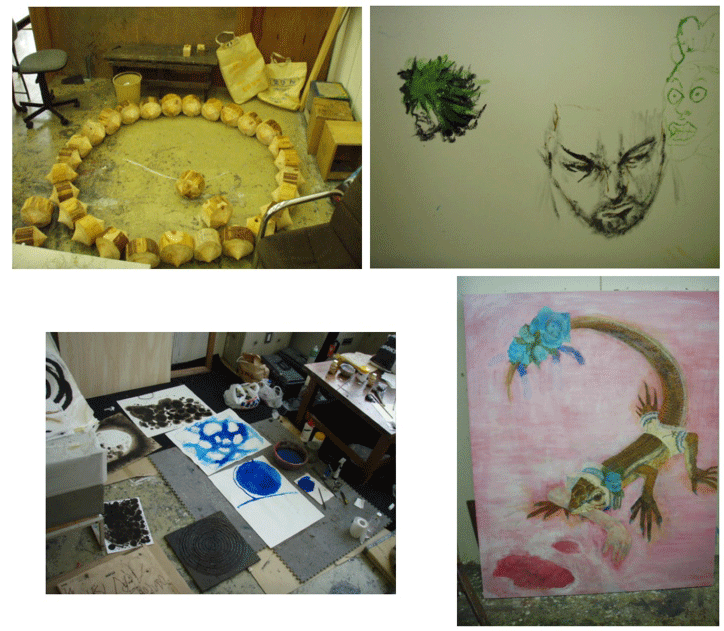
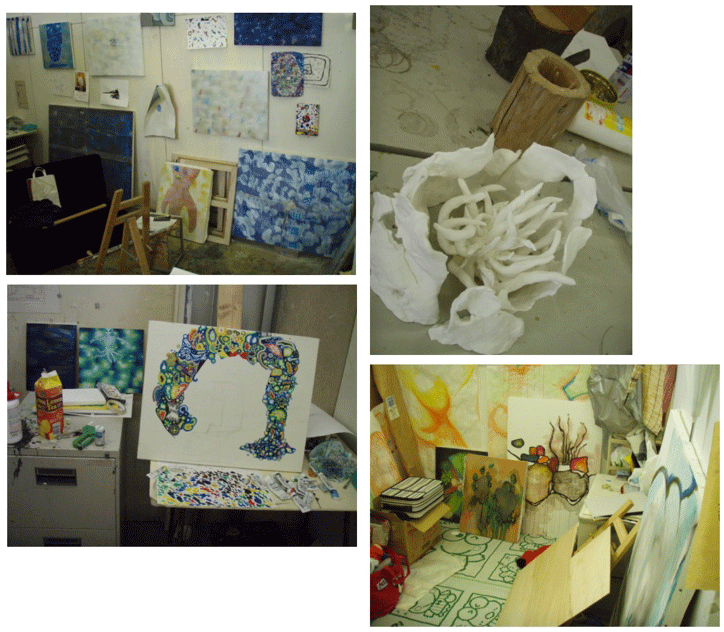
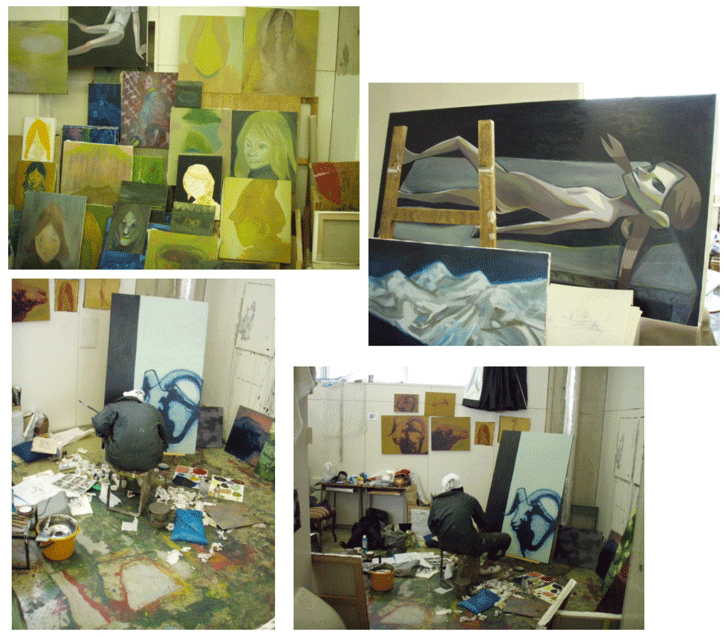
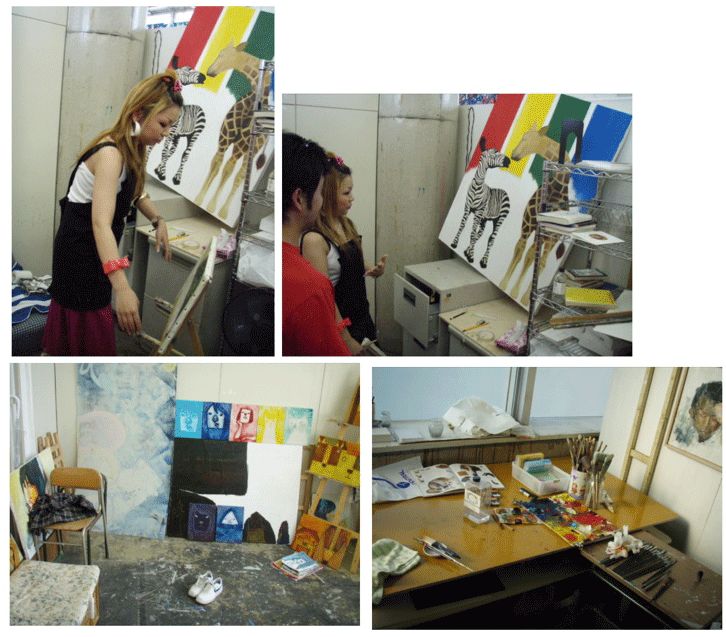

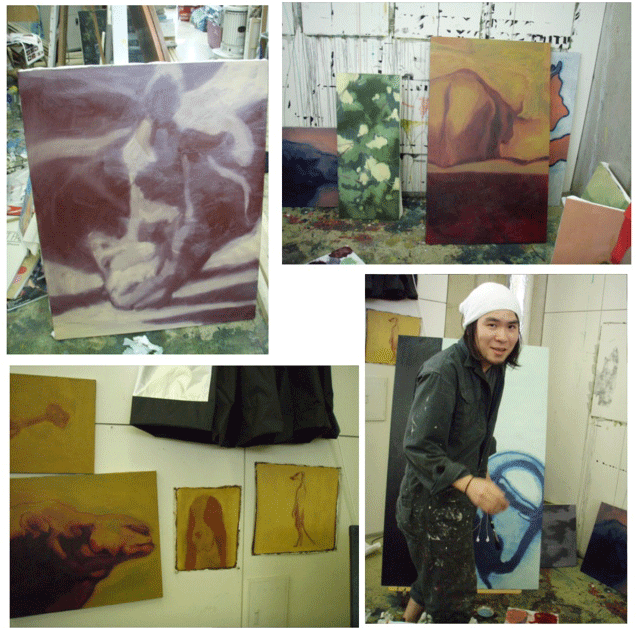
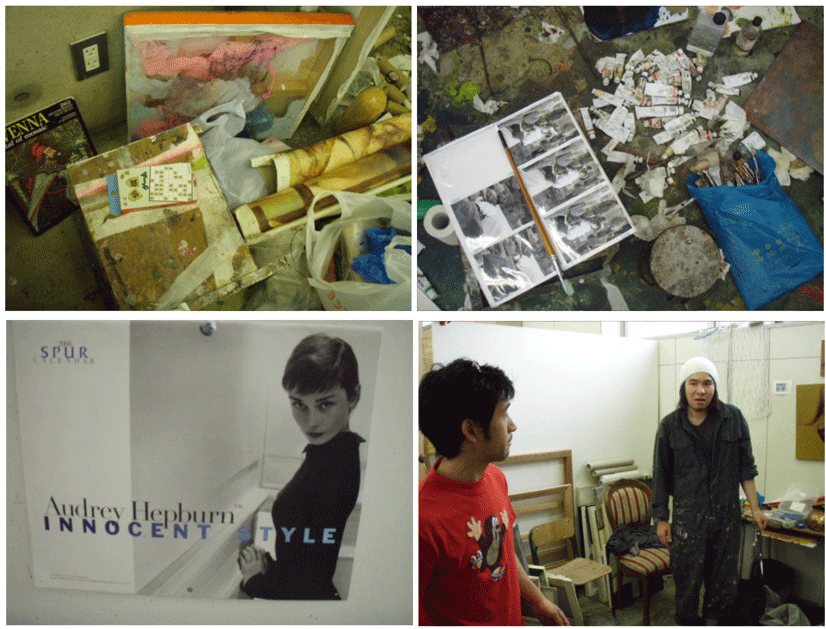
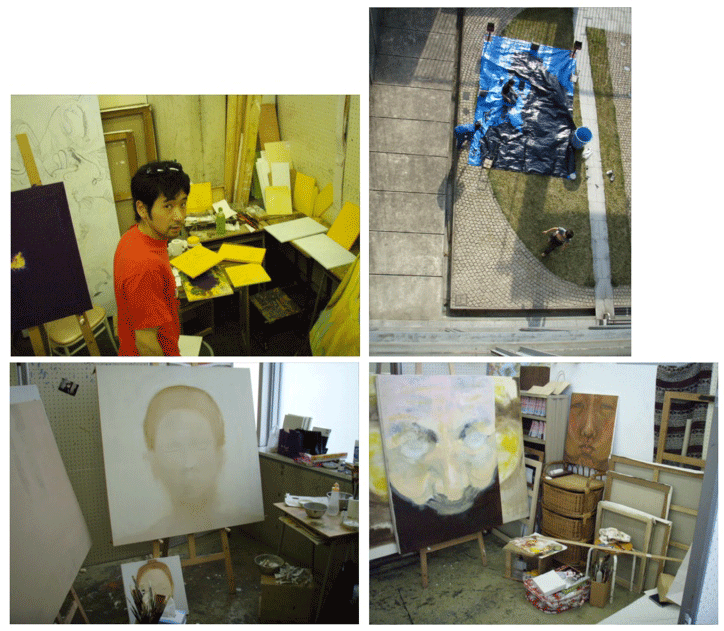
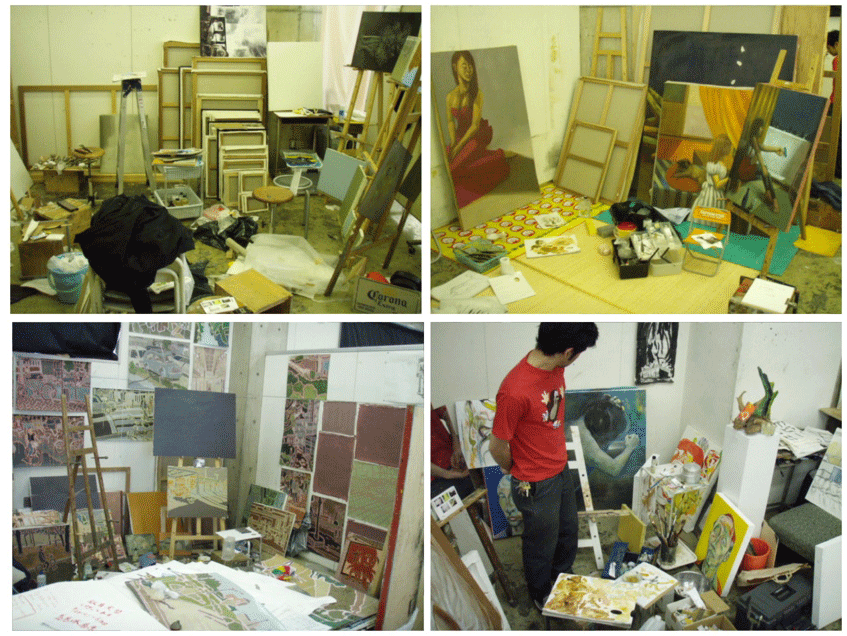
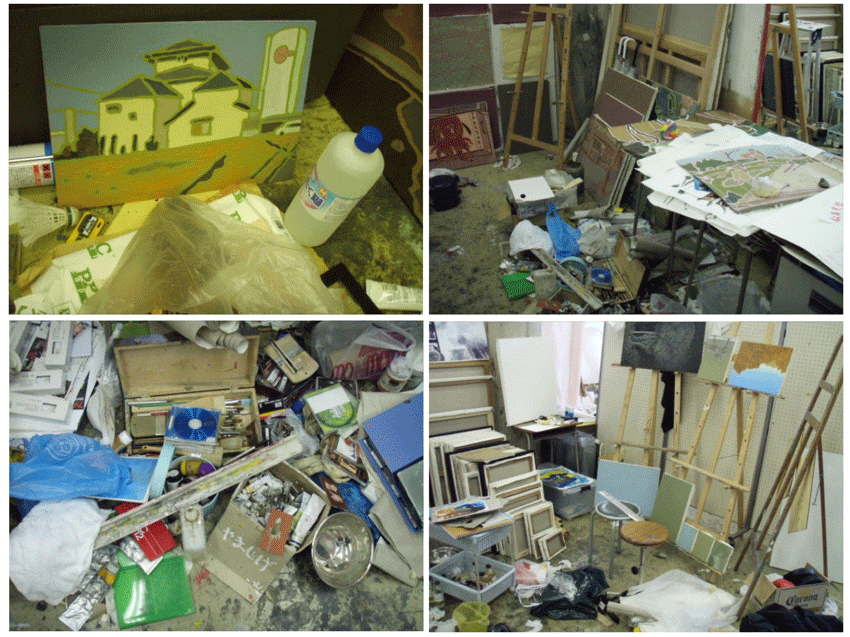
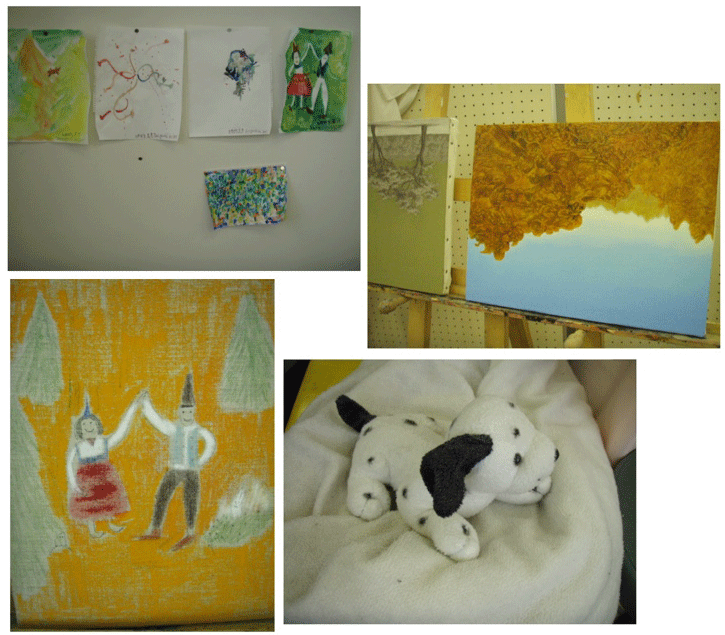
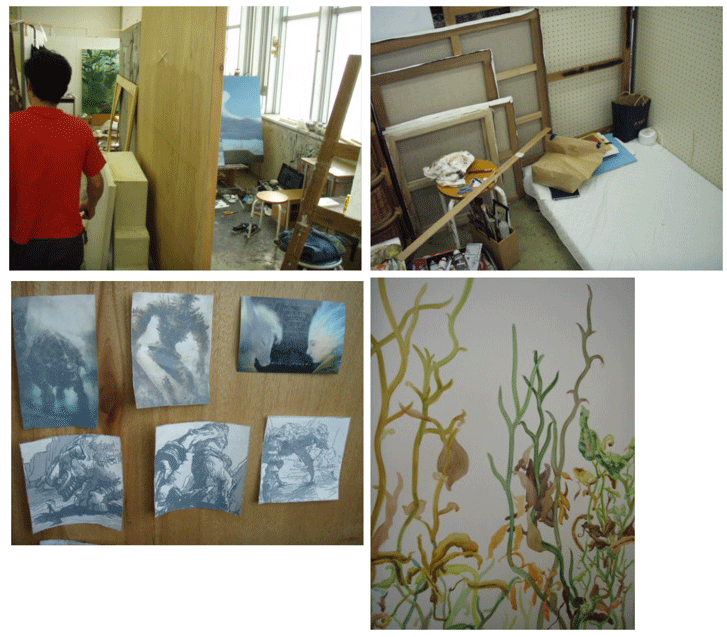
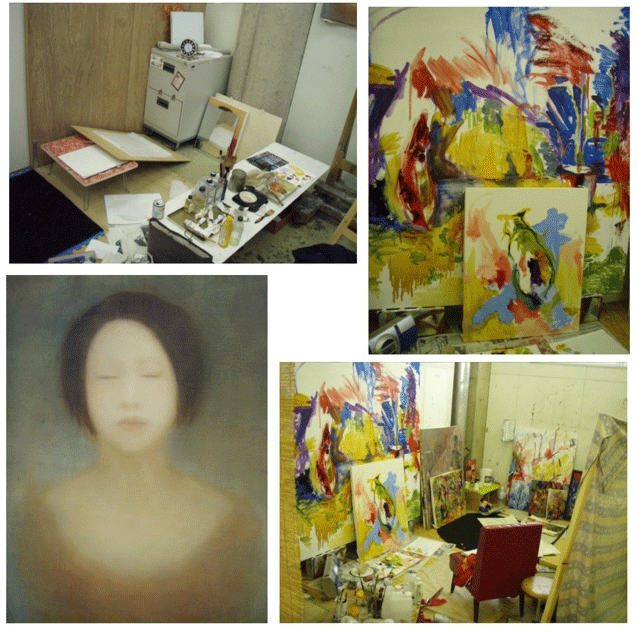
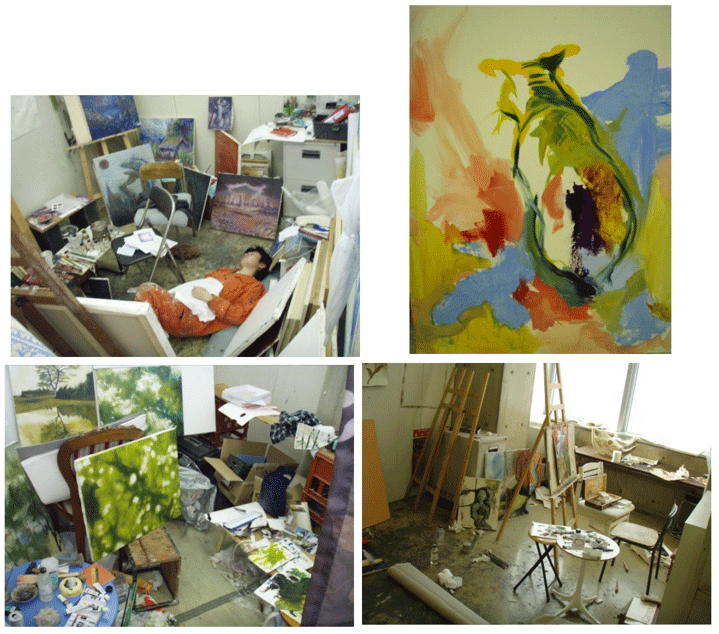
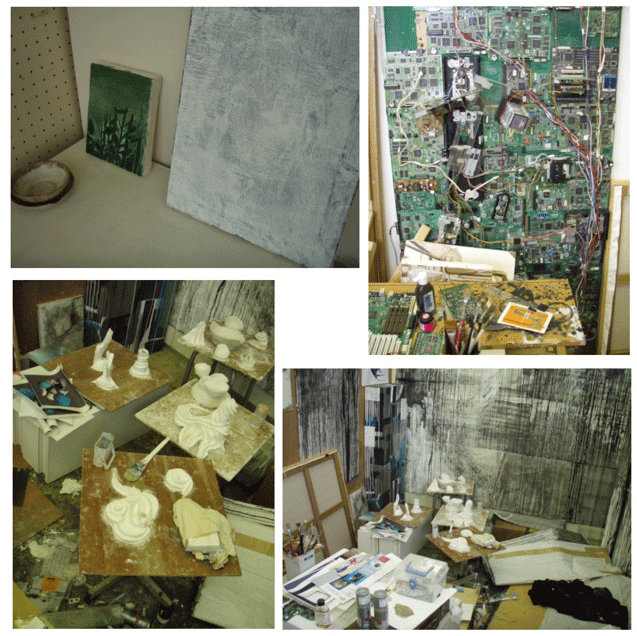

Collaboration, Intoxication and Vulnerability
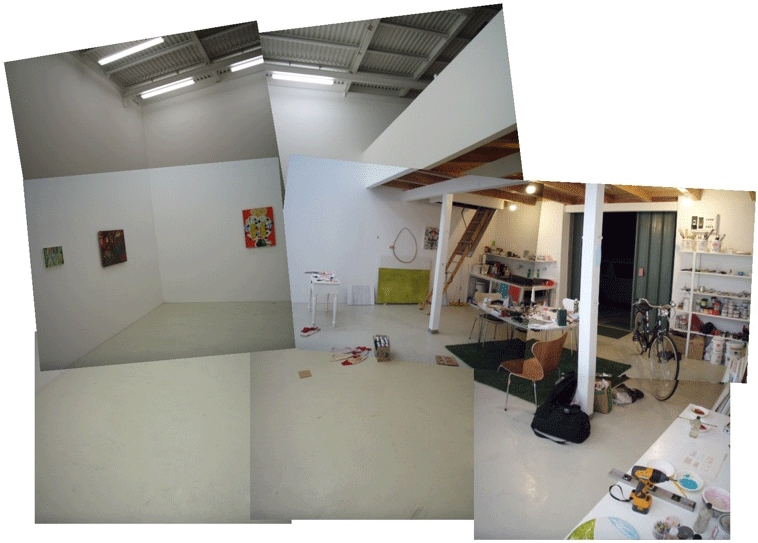
When one travels and visits a friend, one normally does not want to arrive empty handed. And lo, I did just that. (I pause here to register the appropriate degree of shame.) So as Hiroshi and I were cruising Nagoya, I was delighted when we ducked into a art supply store. I realized that I would be able to score the materials to craft something that might become a painting enough to give him as a token of my appreciation before I returned to Los Angeles. I was delighted further still when Hiroshi indicated that he would like to paint along with me. I remembered that Hiroshi and Yoshitomo collaborated for a time in Germany, so he was primed for the occasion.
Little did I know how hardcore Hiroshi was. We arrived at his second studio (yes, he has multiple studios in Nagoya, a fact that simply amazes me still) around seven in the evening. At first, I thought we would hang out, tlak for a bit and Hiroshi would be off. But we painted through the night and into the morning as the sun began to brighten the sky, jet-lag and late-cycle bronchial infection be damned.
The whole experience was first rate.
I could relate the evening with a narration but the pictures you see here tell the story better and more eloquently than my craft with words can allow. Besides, I think that there is something vulgar or misleading in a literal description of the process of art creation. The thought pattern during painting is an avalanche of switchbacks, alternate strategy, simulated pass throughs, soul shredding doubt, all too brief moments of exhultation, bright ideas, dread, blank unscalable walls, fast gambits, the comfort of procedure and established protocol, wreckless trust in a muscle's twitch, the pleasure of the connection of head/eye/arm/hand. Instead, I would like to tell you about a thought pattern I had as I awoke that morning after, for what will follow is essentially a slightly shaped stream of consciousness flow, typed from a bed in a squinted shuttered morning twilight. Hiroshi used his studio as a guest quarters and I had the place to myself as he returned to own house/primary studio after the all nighter.
Hiroshi was a great host. His study above made a nice guest room and a bicycle can take me to the corner store. Coffee was here. Your breakfast is here. A bathroom was accessable from the outside, so sunglasses were at the ready as I recuperated late into the new day. It was nice to hang out alone in the outskirts of Nagoya in that morning after.

I was listening to podcasts in the morning on my laptop after a sleep made fitful by a combination of jet-lag, a bronchial hack and a habitual nap impulse that compels me to sleep for short intervals when I am painting. It was combat-traveller-protocol time as I bathed out of Hiroshi's studio sink, keeping the huge studio doors shut to the intense Japanese mid day summer light. As the computer played out my infotainment, a constellation of thoughts began to converge.... (by the way, I may write/speak/think in ways that seem like a series of digressions, but actually I think I do the opposite: I am instead a congressor).

First up in my iTunes library: Los Angeles radio talk show host Dennis Prager was talking about intoxication in his 5/24/07n podcast titled "Why Do People Get Drunk?". Dennis Prager is a supremely interesting personality, a kind of rabbi for me. (If you're interested, check out his transcripts here for example, his interview with Howard Zinn.) I believe that in our unfortunate culture wars in the USA, there are certain conservative thinkers who have mounted significant critiques of the cultural left that deserve serious consideration by those of us on this side of the political spectrum. It is unfortunate that our thinking has rigidified into an inability to listen to critique, especially since we have become incapable of mounting a proper auto-interrogation (I hate such jargon in our discourse, "interrogation", so I use the term with an ironic skepticism). There are several arenas in which we need examine our own worldview, not the least of which is the role that intoxication plays in the creative cultural left. Witness the recent unfortunate deaths of various artworld personalities (I started to list names, but an elision is necessary out of respect and proper circumspection). What is it about us that we are incapable of asking why we repeat the mistakes of the sixties/ seventies/ eighties. Why is it that self destruction by drugs is a recurring condition in our world, a culture that prides itself on possessing so much sophistication? Can't we learn about the nature of this particular cliff that we feel compelled to dance so near? Is it possible to parse that which we have found so valuable from what is essentially a wretchedly ugly form of suicide? Can we become moths who can come to know that the flame will kill us?

Dennis Prager himself is ruthless on the topic. As I have said, he is a rabbi of sorts for me, but here he and I part ways albeit in a small but important way. Prager takes the position that intoxication by drugs and alcohol is a reflection of a life which lacks meaning because there is no commitment to a superior being (G-d). Without G-d, life is absurd, as he is fond of saying. It is a powerful argument, to be sure. Let's follow the significance of this. Indeed, we in the creative-cultural-political left should heed his critique since there exists an argument that art requires meaning to exist; that it is the dialog throughout art history in the West that defines art as we know it, that nihilism obviates art itself; that once one has discovers oneself in a discussion with someone who has been found to be fundamentally nonsensical, then that dialog has ended. If a dialog has ended or never existed in the first place, there can be no artworld. The existence of an artworld itself presupposes meaning... therefore, G-d exists or is otherwise present... therefore nihilists can't be artists... Q.E.D.. That's quite a bee in our secular bonnet, isn't it?

But Prager and I don't differ in the belief in the presence of G-d. It is that he sees no role whatsoever in the validation of intoxication and obviously I do. Moths or Icarus, flying is satisfying so long as our wax doesn't melt. Now, a point of clarification is in order: I would hope that one might infer from the fourth paragraph of this missive that I am not an advocate of suicide by addictive intoxication. Like most politically controversial topics, there is a continuum in which people have staked out different positions and therefore we battle over which line should be drawn where. Abortion is a good example: where does life begin and when does a life have autonomy or when is it merely a tissue formation like any other? (Let's keep this as a passing example right now, I am a converger, not a digressor, remember?) I think it is interesting that Dennis Prager takes such a strident position since he is an avowed cigar smoker. Tobacco is a substance that I would place on the continuum of intoxicants. My father was a smoker to such a degree that he required oxygen bottles toward the end of his life.
I like to joke with my friend Bart Exposito in that I tell everyone that he taught me how to smoke. Now, I do smoke a cigarette now and then, and I usually do so for two reasons, the strongest is that I do it in rememberance of my father. The other is that once I am drinking alcohol socially, a drag on a cigarette is particularly interesting in that it completes the experience. I think also that there is something profound in the irony of toasting life with a cocktail and a drag on a cancer stick (or "coffin nails" as they were once called). But let me not yet jump to the conclusion of this argument too quickly. And for the record, Hiroshi doesn't believe in alcohol or drugs of any kind. He does smoke tobacco enthusiastically, however. I think such substances are in the world G-d provided for us, and as such there is a purpose with which we have a responsibility to manage. So far, so good as far as divulging my position on such a topic.

The next podcast that I listened to that morning after was the very interesting fruit from Chicago, "Bad at Sports". It was Bad at Sports' Episode 77's interview with painter Jose Lerma. I met Jose briefly in Texas back in 2003, a genial, low key and interesting guy with hidden depths. I was keen to see what he is up to nowadays. Midway through the interview hosted by Duncan MacEnzie and Amanda Browder, they kicked in with a discussion of the role of abstraction versus representation:
32:13At this point with the mention of modernism, I imagine a kind of anxiety kicked in for Duncan. A signifying flag of post-modern awareness had to tossed out on the playing field, heavily ladened with the required sarcasm as ironic distance was reasserted:
J.L.: "The reason why I stick with the figure and not go fully into abstraction uh, it has to do more with the fact that I can consider that kind of semi-representational painting to be more complex and a harder read for the viewer. What I mean by that is that, uh you know that abstract space for me is infinite space, there's no point of reference but once you have the body as a reference, you can kind of play off opposites. You can cancel sort of, by just knowing in that you can understand how a body works in space, you can sort of cancel the way it's painted. You can paint the projecting the projecting parts in a way that you feel like they are receding. That's what I mean, it's completely abstract, you don't have that kind of advantage."D.M.: "You can use color and shade to kind of create that space, rather than...
J.L.: "Yea... and not just a purely optical space, but there's a kind of phenomenological thing that happens that you can sort of understand how an elbow projects and you can sort of use that as a, as a means of sort of making a complex painting. You might have thinner parts, thicker parts, you know, colors that project, colors that recede, warmer...you know, all those things, sort of playing opposites, of sort of the mental concepts you have of an object. And I think with.. and a I have a problem with doing that sort of in a purely abstract way that's not tied to anything. This is just like, painter..."
33:50
J.L.: "You can wreck to the point where it almost doesn't work and then... bring it... I mean that I really sort of, like my painting, if I had to attach it to anything, it's probably more early modern in the way i approach the figure, you know, it's very much formal, and very much sort of the place where the loose conception of the figure, you know. I don't, I don't, you know, use that kind of projector or something like that...."
D.M.: "So you can take a, a figurative painting and wreck it so that it doesn't, doesn't work the way it is supposed to..."
34:17
D.M.: "Wow that was heavy painter talk. That was ah --sorry about that, wow. I just went all out technical. What the hell's going on?"

Personally, I think that abstraction and representation exist on a continuum, like the ordinates of north and south on a compass rose. A disavowal of one for the other seems kooky to me. Now, kookiness is not a blemish that I would assign to Jose's thinking. Sticking with figuration and countering abstraction is what he needs to construct a position that will support and extend his affinities. He's a remarkable painter and I look with interest to whatever he presents to the world. But ever since I read Gombrich's "Art an Illusion", I've been convinced that we are pattern seeking creatures. I do agree with Jose in that the patterns that we induce in our work can be made to conflict in degrees. Perhaps one ramification of what I am proposing is that abstraction can only exist in the most extreme or even an impossible or evanescent state. It is in this that I see the significance of the Didion quote, the phantasmagoria that adorns the colophon of this blog. Is abstraction another name for phantazmagoria? Phantasmagoria is literally a confusion of sensations, the state that precedes incipient cognition, Lao Tzu's "myriad creatures". It is an airless fundament, and like diving into the sea, we must eventually come up for air.
Abstraction is (along this line of thinking that is...) ultimately furtive and evasive and a glimpse is all we can take in at any moment. If abstraction is something that exists but for a moment for our pattern seeking eye/brains, then it should follow that figuration is always breaking down at the same time since negotiating the world is a constant reconfiguration. The gestalt of figuring the world is not a singular experience but multiple, spontaneous, cascading, forever in a state of becoming and unravelling. Paint itself is made of binders and solvents, countervailing complementaries, like a clutch-gas-brake in a motor vehicle. The play of one into the other, back and forth as one accelerates or decelerates takes us closer to the truth of the experience of art.*1
Abstraction also exists at the price of rupture and frustration, that comes with the grinding of the gears of sensation. And here is where collaboration becomes interesting. Remember Hiroshi's search for rupture in parallel albeit naive art worlds? (In the next blogpost, I will show pics from our visit to Hiroshi's students at Nagoya University's art program.) During our collaboration that night, we experimented with each other's moves. First, we worked on our own panels and as the evening turned to morning, we jumped back and forth between each other's work, importing discoveries into our own realm. To make anything, one has to congeal enough to take a stand and move forward. But most times, congealment loses innocence and petrifies into orthodoxy and this ossification has to be broken so that the real can bubble up through the crust, even as that too will crust up again. Art is how one makes the break and subsequently manages what oozes forth.
Collaboration as intoxication of sorts. It requires an empathic capacity, the ability to lay down one's guard, the willingness to rupture one's narrative. Intoxication brings vulnerability. It is not a coincidence that alcohol has a longstanding presence in art history since it lowers one's inhibition. And with or without alcohol, life seems to require a mixture of restraint and inhibition. In studio practice a personal narrative describing the integrity of one's vision/process becomes inevitable and against this, the exposure and intrusion of a competing narrative is necessary for growth to move past where one has been and proceed to where one is going.
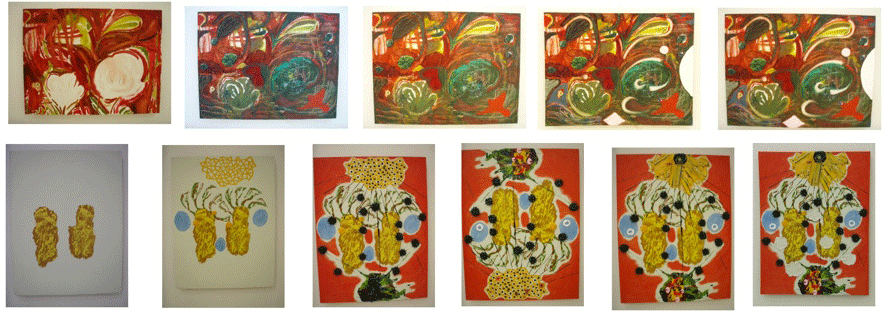
***
*1 A second mind about this idea about an evanescent abstraction: one could say that abstraction itself is also another form of figuration, but on a conceptual realm, a reduction of the world into sign and formula, the way Carl Andre requires the configuration for his sculpture and all the mathematics it implies --spectral thought formation is enough in itself to be a figure. The extremities of semantics aside, I think that considering a conception of abstraction as that which is hard to see/hold because of our ever configuring minds (heavens to Dali!), is substantial enough work for a bright Japanese summer morning.
Nagoya
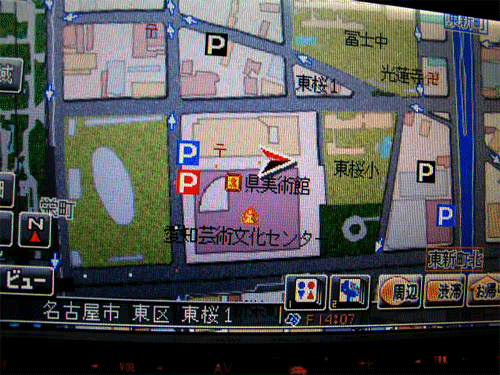
I took the bullet train from Tokyo Station to Nagoya to spend some time with Hiroshi and see his new studio. It's pretty easy to get around in Japan, surprising since there are few signs in english to help the gaijin to get around. But maybe all one needs in Japan is a couple of signs, some color coding and helpful people at the information counters to get around... and a good friend that will drive you to the city center to see somthing interesting at the local museum.
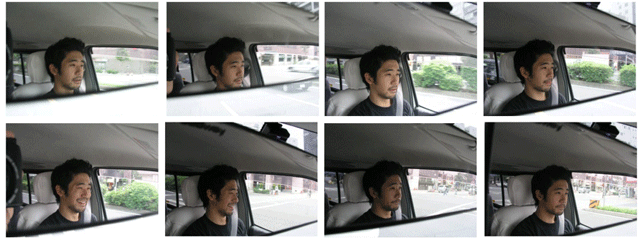
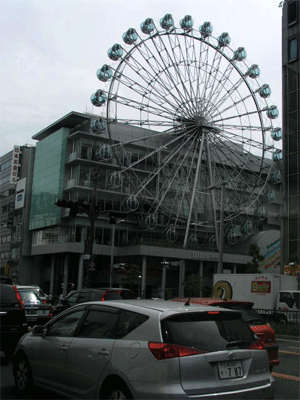
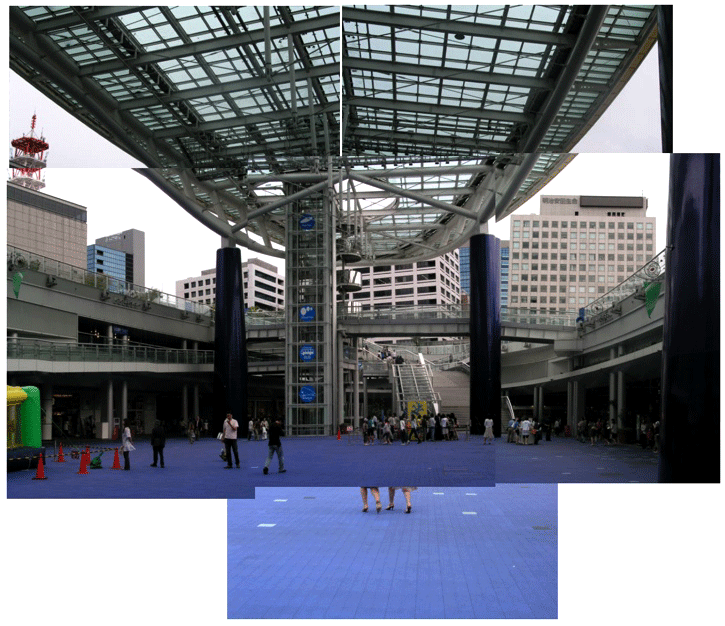
There was a painting that Hiroshi wanted to show me at the Aichi Prefecture Art Center. The Price Collection was touring the "Jakuchu, & the Age of Imagination" and one particular one is worthy of a pilgrimage to see It? JAKUCHU's "Birds , Animals , and Flowering Plants in Imaginary Scene" from the 18 th Century:

I have a book bought from the museum bookstore featuring this painting, and rough fotos of the overall are here, and details here, here, here, and here.
The paintiing is on two folding screens, each about as long as my "Colossus". The books that I had bought of this artist (Jakuchu) indicate that this particular painting was an anomoly (Hiroshi told me that there are only two of this kind for Jakuchu) and in this collection, I saw two other works by Jakuchu that also seem anomolous when I scan the catalogs. The story was that Jakuchu would keep several roosters and study them intensively, painting studies of them exhaustively. I began to see a strategy of representing the world in similar terms: assemblages of a variety of plumages, something that I could relate to in that my paintings also preserve a certain integrity of each mark made within them.
I realised that Hiroshi was focused on the anomolies. Amidst so much accomplishment, excellence in technique, the legendary Japanese intensity of mastery, the stand outs are the knuckleheads and mavericks. Hiroshi pointed out to me the goofs, awkward passages and sheer dumb moves in some of the work on exhibit. It was the cracks in the seams of apparently seamless virtuosity where he found the greatest inspiration.
Later on as we cruised the rest of the building, we checked out the rental galleries that we made available to the general public. I got to see the legendary parallel art world that exists alongside the one that we know of worldwide and in history. I like to say that there are many artworlds and here in Japan this is true in spades. The idea that there are multiple artworlds is eventually organized by a distinction of whether an over arching dialog of art history is being entertained or not. Those who do not incorporate a version of that dialog risks being categorized with the status of an outsider. If you fly your freak flag wildly enough, you might be someone like Henry Darger. If not, you can live a wonderful life, but other art worlds might not care what you do. Parochialism supercharged on steroids.
In Japan, the other artworlds that live so stubbornly without a care about this dialog of art history (that which we get in ready made form in grad school) enjoy an uncommon vitality: they have collectors, galleries, critics, museums... what do they care about this thing called the larger and "more authoritative art dialog"?
And what is interesting is that this outsider artworld inside Japan serves as a kind of laboratory for the cultivation of strange new formal moves, art wise. Hiroshi toured me through the other galleries in the building, ones that are usually rented by artists in this other art world. They would sit their own shows, clicking off the number of visitors with that pensive anxiety that is all too familiar to those of us who pretend we don't feel such things at our own shows. Hiroshi would peruse the shows and savor the naive parts, mushrooms of vitality sprouting in the odd corners of a forest of cliche. "Isn't that wonderful?" he would beam.
***

Later in my Nagoya visit, Hiroshi took me to the outskirts of town where he has his other studios and where he teaches at the local university. As far as I could tell, Nagoya has an urban zoning scheme like Houston: none to speak of. This part of his neighborhood outside the municipality proper was an industrial zone, but the scale of business was beautiful to me in terms of their small scale. And the mixture of residential, retail, factory and farm was lovely to my eyes.
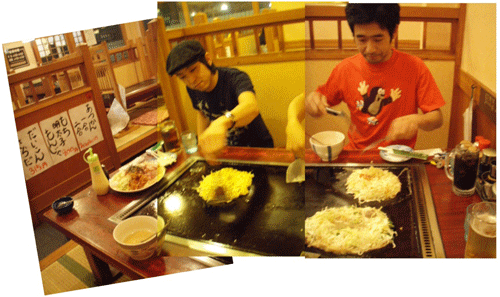
My final night in Nagoya was celebrated with a dinner called "Monja", a meal made popular in post war times when food shortages prompted mothers to create a dish for their children returning from school in the afternoon who were hungry for a snack. A pile of cabbage on a hot plate, half a baby's fist of meat (what used to be left overs) and a bowl of water mixed with wheat flour. As the cabbage softened, a moat is made and the wheat water is poured and allowed to congeal and crispen. Large spatulas manage the pile and small spatulas were used to press and sear bits into the cooking surface, sticking the bits onto the utensil to eat in small bits. The whole event was tricky to manage and I imagine that this kept the kids busy while satiating their hunger without stuffing them with food. It was a great meal that I found quite satisfying without that voluminous bloat so familiar stateside.
June 8, 2007
Architecture Notes: TKG & House

Hiroshi Sugito and I stepped out to find Tomio Koyama's new house that he has built in the middle of Tokyo, a single subway stop from the gallery. This day was the all significant punch list day, the last opportunity to catch the critically niggling details that could make or break any building... it was also a first opportunity to see and celebrate this special new construction.
Like my last trip to New York with Aaron Parazette, I tend to exploit the opportunity to take in a view of ambient urban environments while a collegue has taken on the burden of navigation. Yes, there's a whiff of infantilism there, that's true. But while I am in tow, all swivel necked and goggle eyed (like a bebe), the city is such a marvel.
When I am in Amsterdam, I love getting lost in that place, it is such an architectural/urban jewel, every aspect responds to your presence. And Tokyo is no less astounding, perhaps especially in mirror form since this city is a look into the future as much as Amsterdam is a look into the past.
This time, Hiroshi was the default guide as we looked for the location of Tomio's new house somewhere on the east side of Tokyo. What was interesting was that after we progressed through the immaculate subway system and popped into the lively buzzing city street, a huge scaled overhead structure for an elevated roadway roared. You nearly had to shout to be heard. Hiroshi flipped open his cell to navigate to Tomio's address. We chose the direction and after we ducked into cross street, the noise level dramtically dropped as fast as the scale of the surrounding two and three story buidings.
This is where Tomio has built his first house.
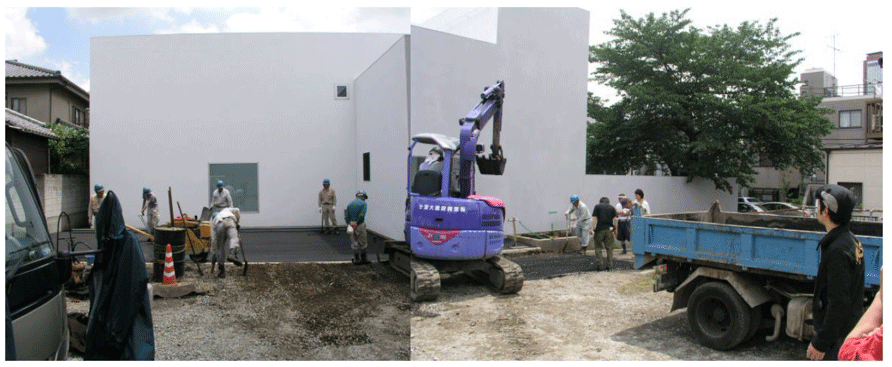

Jun Aoki, Tomio's architect, recently created the Aomori Museum, came out of the house of Isozaki and established his practice in the early 90's. He explained to me that the surraounding walls are determined by contextual issues and openings in the walls are perfect squares. I smiled and said that between the two is a philosophy.

At the entry, the shoes come off. From a kind of foyer, Four squares puncture the space: the fourth wall at the shoes, a passage to the enclosed garden built around a cherry tree that's over a hundred years old, a small window to the parking that sports a strange prismatic mirror aspect that expands angle number of angles of vision towards the parking lot (which the crew is asphalting on this day), and a square that opens both into the house to the right and to a guest studio for Tomio's visiting artists complete with a studio and pocket loft/bathroom to the side.
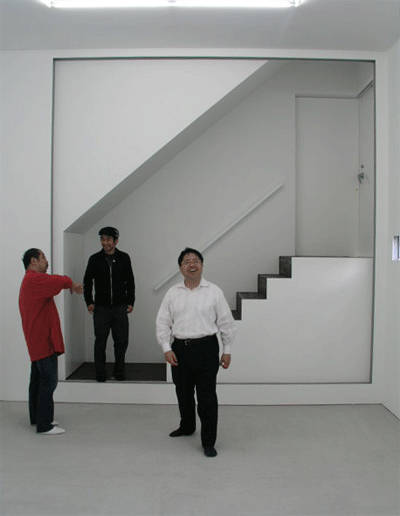
I'm looking forward to moving mounds of paint in this place someday.
Check out the details of the zone between inner and outer layers of the walls where all systems seem to course subcutaneously here and here.

This stair passage to the second floor exists in this in in-between zone that divides the public and private areas. Details required special transitions from drywall to something that must resemble MDF to render a paper thin idea of the interior wall; smooth grey carpet inset flawlessly, grey and white paint must have been applied with tiny brushes; several and various valance systems help manage the Tokyo light; I spotted electrical switches there too.
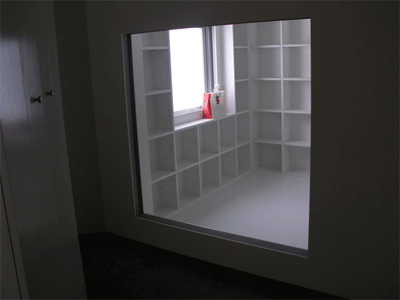
I like how Tomio has to step into his study, Alice in Wonderland style.
***
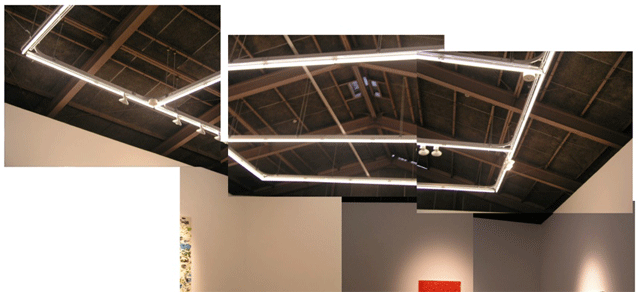
And TKG, Tomio Koyama Gallery? The gallery is the third incarnation. I showed three previous exhibitions at his first space a few blocks down the street at Koto-ku across the Sumida River. The current space is in a butler style metal prefabricated building assembled atop an old concrete reinforced warehouse that is now the home to a number of galleries, another cluster now so familiar in any significant art city. Hiroshi dropped knowledge at the start of the design stage, suggesting the box within the box idea that allowed a number of offices and storage space the gallery needs. The gallery can be serviced from this perimeter, allowing any kind of installation to flop their systems into that space (video, etc.).
And by the way, Tomio has the best lighting system ever : a tandem incandescent and fluorescent combo, dimable on multiple rheostats. Verrrrrry nice, that.
June 5, 2007
Admin: Rolling Home
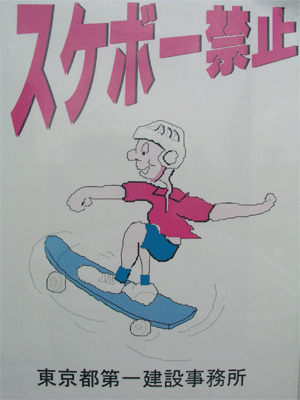
I'm sitting here, early at Narita Airport with an abundance of caution after my previous traveller's gaffe (boot to the Sunday section if you're researching the reference). The upper respiratory infection has done it's dark work but it didn't spoil the fine opening and cultural intercourse that I enjoyed here in Japan. I've got a blogsac full of interesting items that I am in the process of unpacking and processing for discretion and social sensitivity (a public diarist has to be careful not to burn the world down with verbal diarrhea, not an easy task for someone of my character).
The upshot: I had a great time, learned a few things, met some new people and gratefully renewed contact with old acquantances and strengthened bonds with good friends. All in all, super fantastic.
Please stay tuned, more to come.
June 2, 2007
The Opening

(BLOGPOST IN PROGRESS)

Shortly before the opening, I talked to Mutsuko Ota editor for Esquire Magazine Japan (and all around renaissance man) in an interview that lasted quite a while and was completely delightful. The tough question: "What is painting?". I could recount the answer here... it might take a while... but I can describe quickly how I ended my answer: with a reference to the Zen koan (case #14) that answers with my boot pulled off my foot and placed on my head.
Then there's that other zen master, the alternative answer.
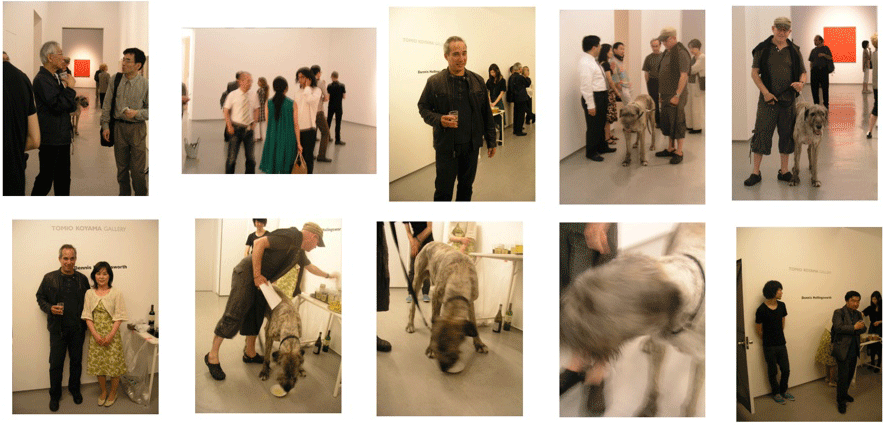
Longtime Tokyo expat (so long an expat that he's as Japanese as such an expat can possibly be) Johnnie Walker blessed the openign by showing up with his magnificent Russian Wolfhound. He told me the story of how his neighbors called the police when he first walked his dog, reporting that someone has a bear on a leash in the 'hood. His dog had a jones for beer, and Johnnie was able to channel the beast's energy with commands in an ancient country Japanese dialect. The Wolfhound lapped it up slowly, pausing to savor the flavor.
Oh yea, and Johnnie Walker's relation to the artworld? He is running an artist residency program based in Tokyo. I asked: "Something like the Glassel School in Houston?" Yea, that's right, was his response.

This was the first opportunity I've had to step back and shoot this frontal shot of "Colossus".
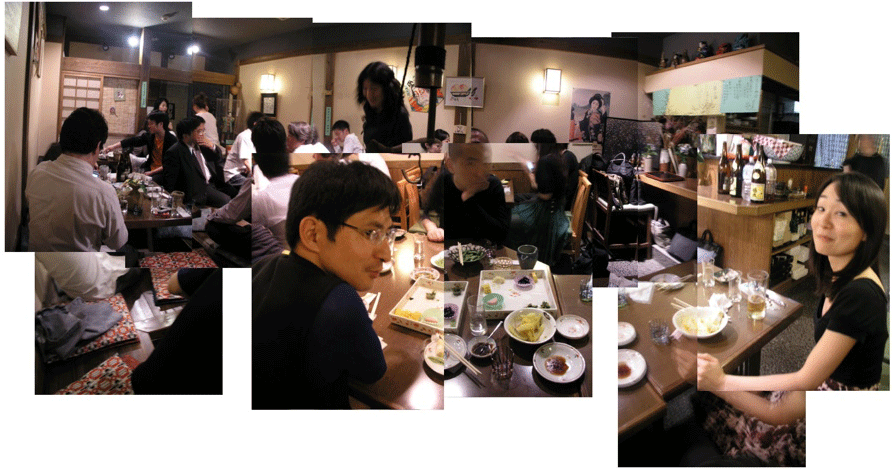
(BLOGPOST in PROGRESS)
So I'm Rollin' Back in the Cab
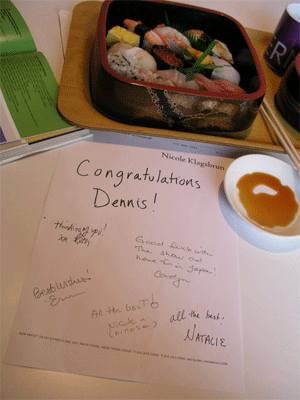
So I was rolling back in the cab with Tomio and I told him that I was feeling a bit ill before the opening, a low level bronchial thing (I tried to sleep it off before the show but no luck). During the interview (with Japanese Esquire Magazine) I was clouding over and I had a small headache during the reception, I was feeling a little off... but after all that sake, I'm feeling quite fine. (The last line in a sing-song voice)
Tomio said "Oh, that's a little dangerous."
We got out of the taxi as I made a mental note ot drink loads of water before I fell into bed.
The blogsac is full but I've got to get some clearances after some of Tomio's staff have gotten wise to my itchy picture posting trigger finger. They made me promise not to blog the pics I took of the after party.
More to come....
